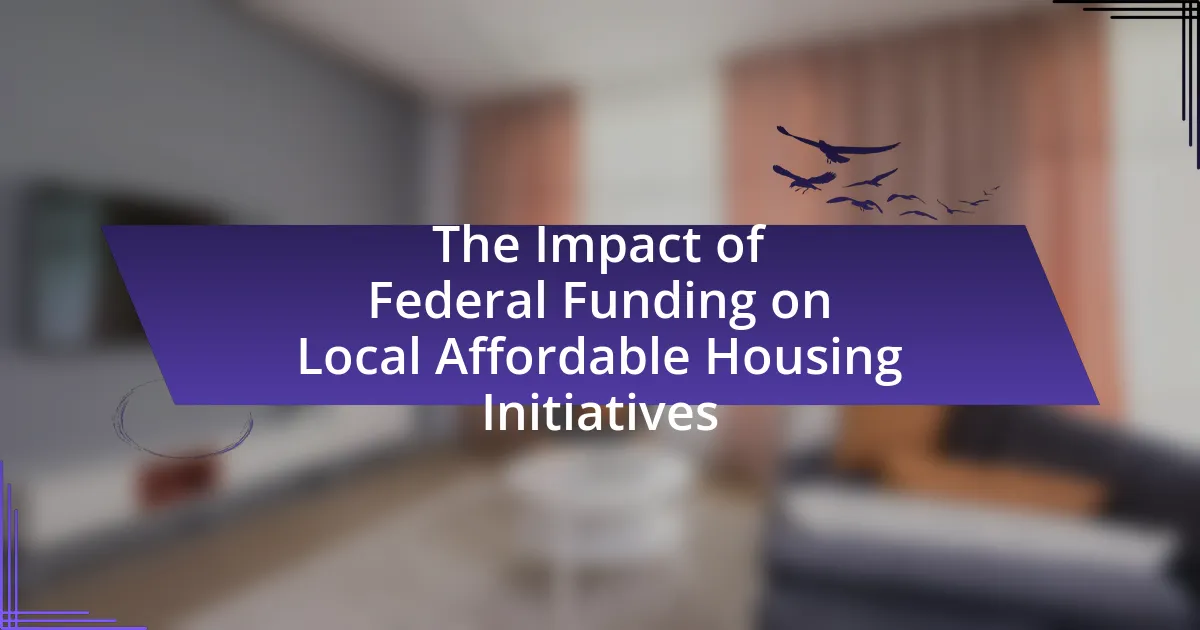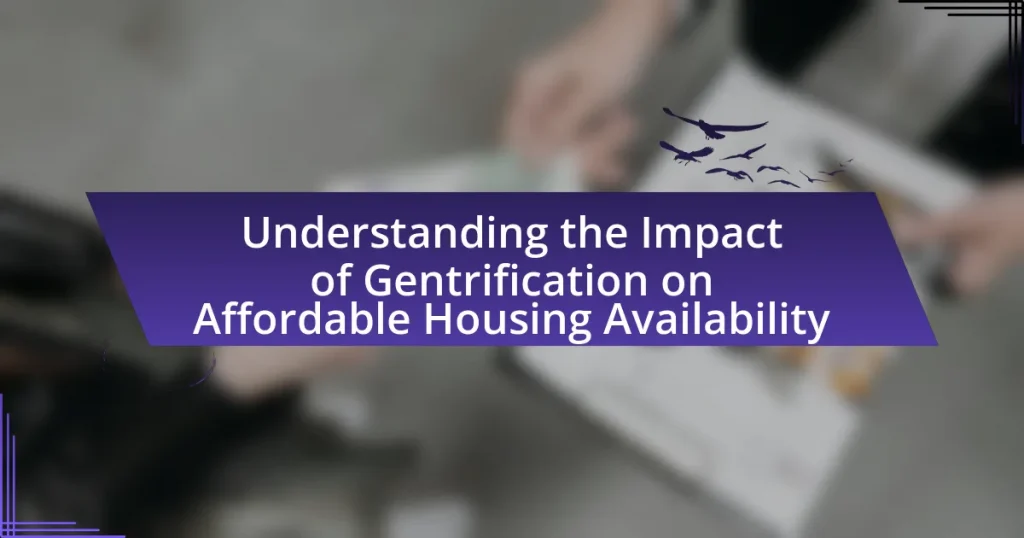Federal funding plays a crucial role in enhancing local affordable housing initiatives by providing essential financial resources for the development and preservation of affordable housing units. Key programs such as the Low-Income Housing Tax Credit, Community Development Block Grants, and the HOME Investment Partnerships Program have facilitated the creation of millions of affordable housing units and improved living conditions for low-income families. Local governments access these funds through applications that align with federal objectives, enabling them to address housing shortages effectively. The article examines the types of federal funding available, the challenges faced by local initiatives without such support, and best practices for maximizing funding opportunities to ensure sustainable and quality housing solutions in communities.

What is the Impact of Federal Funding on Local Affordable Housing Initiatives?
Federal funding significantly enhances local affordable housing initiatives by providing essential financial resources that enable the development and preservation of affordable housing units. For instance, programs like the Low-Income Housing Tax Credit (LIHTC) have facilitated the creation of over 3 million affordable housing units since its inception in 1986, demonstrating the effectiveness of federal investment in local housing markets. Additionally, federal grants and subsidies help local governments and non-profit organizations leverage additional funding, thereby amplifying their capacity to address housing shortages and improve living conditions for low-income families.
How does federal funding influence local affordable housing projects?
Federal funding significantly influences local affordable housing projects by providing essential financial resources that enable the development and maintenance of such initiatives. This funding often comes through programs like the Low-Income Housing Tax Credit, which incentivizes private investment in affordable housing, or through direct grants from agencies such as the Department of Housing and Urban Development. For instance, in 2020, the federal government allocated approximately $10 billion to the Housing Trust Fund, which directly supports the construction and rehabilitation of rental housing for extremely low-income families. This financial support not only helps to lower construction costs but also ensures that projects can be completed in a timely manner, ultimately increasing the availability of affordable housing units in local communities.
What types of federal funding are available for affordable housing?
Federal funding for affordable housing primarily includes the Low-Income Housing Tax Credit (LIHTC), Community Development Block Grants (CDBG), and the HOME Investment Partnerships Program. The LIHTC incentivizes private investment in affordable housing by providing tax credits to developers, which has led to the creation of over 3 million affordable housing units since its inception in 1986. CDBG funds are allocated to local governments for a variety of community development activities, including affordable housing projects, with approximately $3 billion distributed annually. The HOME program provides grants to states and localities to create affordable housing for low-income households, contributing to the development of over 1 million units since 1990. These funding sources are crucial for supporting local initiatives aimed at increasing affordable housing availability.
How do local governments access federal funding for housing initiatives?
Local governments access federal funding for housing initiatives primarily through programs administered by the U.S. Department of Housing and Urban Development (HUD). These programs include Community Development Block Grants (CDBG), HOME Investment Partnerships Program, and various competitive grant opportunities. Local governments must submit applications that outline their proposed projects, demonstrating how they align with federal objectives, such as increasing affordable housing and improving community infrastructure.
For instance, in fiscal year 2022, HUD allocated approximately $3 billion in CDBG funding, which local governments utilized to support housing initiatives. Additionally, local governments often collaborate with nonprofit organizations and private developers to enhance their proposals, thereby increasing their chances of securing funding.
Why is federal funding crucial for affordable housing initiatives?
Federal funding is crucial for affordable housing initiatives because it provides essential financial resources that enable the development and maintenance of affordable housing projects. Without federal funding, local governments and organizations often lack the necessary capital to address the significant demand for affordable housing, which is evidenced by the National Low Income Housing Coalition’s report indicating a shortage of 7 million affordable rental homes for extremely low-income renters in the United States. This funding supports various programs, such as the Low-Income Housing Tax Credit and Community Development Block Grants, which directly contribute to increasing the availability of affordable housing units and improving living conditions for low-income families.
What challenges do local initiatives face without federal support?
Local initiatives face significant challenges without federal support, primarily due to limited financial resources. Without federal funding, these initiatives struggle to secure adequate funding for affordable housing projects, leading to reduced capacity to develop and maintain housing. For instance, a report from the National Low Income Housing Coalition indicates that local programs often rely on federal grants and subsidies to bridge funding gaps; without these, they may be unable to meet community housing needs effectively. Additionally, the absence of federal support can hinder collaboration with larger organizations that typically provide expertise and additional resources, further isolating local efforts.
How does federal funding enhance the effectiveness of local programs?
Federal funding enhances the effectiveness of local programs by providing essential financial resources that enable the implementation and expansion of initiatives. For instance, federal grants and subsidies can significantly increase the budget available for local affordable housing projects, allowing for the construction of more units and the improvement of existing facilities. According to the U.S. Department of Housing and Urban Development, federal funding has supported the development of over 1.3 million affordable housing units since 2010, demonstrating its critical role in addressing local housing needs. This financial support not only facilitates immediate project execution but also fosters long-term sustainability and community development, ultimately leading to improved living conditions and economic stability for residents.
What are the outcomes of federal funding on local affordable housing initiatives?
Federal funding significantly enhances local affordable housing initiatives by providing essential financial resources that enable the construction and rehabilitation of affordable housing units. For instance, the U.S. Department of Housing and Urban Development (HUD) allocates billions annually through programs like the Community Development Block Grant (CDBG) and the HOME Investment Partnerships Program, which directly support local governments and non-profit organizations in their housing efforts. These funds have been shown to increase the availability of affordable housing, reduce homelessness, and improve living conditions in underserved communities, as evidenced by studies indicating that areas receiving federal funding see a marked increase in affordable housing stock and a decrease in housing cost burdens for low-income families.
How does federal funding affect the availability of affordable housing units?
Federal funding significantly increases the availability of affordable housing units by providing financial resources for construction, rehabilitation, and maintenance. Programs such as the Low-Income Housing Tax Credit and Community Development Block Grants allocate billions annually, enabling local governments and developers to create and sustain affordable housing projects. For instance, in 2020, the federal government allocated approximately $10 billion through the Housing Trust Fund, directly contributing to the development of thousands of affordable housing units across the United States. This funding not only supports new construction but also helps preserve existing affordable housing, thereby addressing the critical shortage of such units in many communities.
What impact does federal funding have on housing quality and sustainability?
Federal funding significantly enhances housing quality and sustainability by providing essential financial resources for construction, rehabilitation, and maintenance of affordable housing. This funding often supports initiatives that incorporate energy-efficient designs and sustainable materials, leading to lower utility costs and reduced environmental impact. For instance, the U.S. Department of Housing and Urban Development (HUD) allocates billions annually to programs like the Community Development Block Grant, which has been shown to improve housing conditions and promote sustainable practices in local communities. Studies indicate that areas receiving federal funding experience a marked increase in housing stability and quality, as evidenced by improved building codes and increased access to modern amenities.
How do local governments prioritize federal funding for housing initiatives?
Local governments prioritize federal funding for housing initiatives by assessing community needs, aligning with strategic goals, and leveraging data-driven decision-making. They often conduct needs assessments to identify housing shortages and demographic trends, which inform their funding priorities. For instance, the U.S. Department of Housing and Urban Development (HUD) provides guidelines and funding opportunities that local governments utilize to address specific housing challenges, such as homelessness or affordable housing shortages. Additionally, local governments may prioritize projects that demonstrate potential for economic development or community revitalization, ensuring that federal funds are allocated to initiatives that yield the highest impact. This approach is supported by evidence from various studies indicating that targeted funding leads to more effective housing solutions and improved community outcomes.
What strategies can local initiatives employ to maximize federal funding?
Local initiatives can maximize federal funding by developing comprehensive proposals that align with federal priorities and demonstrating community need. These proposals should include detailed budgets, clear objectives, and measurable outcomes to showcase the potential impact of the funding. Additionally, local initiatives can engage in partnerships with other organizations to strengthen their applications, as collaborative efforts often attract more attention from federal agencies. Evidence of community support, such as letters of endorsement from stakeholders, can further enhance the credibility of the proposals. According to the National Low Income Housing Coalition, initiatives that effectively communicate their alignment with federal goals and demonstrate local support are more likely to secure funding.
What best practices should local affordable housing initiatives follow to leverage federal funding effectively?
Local affordable housing initiatives should establish strong partnerships with federal, state, and local agencies to leverage federal funding effectively. Collaborating with these entities enhances access to resources and expertise, which can lead to more successful funding applications. For instance, initiatives that align their goals with federal priorities, such as the U.S. Department of Housing and Urban Development’s focus on reducing homelessness, are more likely to secure funding. Additionally, maintaining transparency and accountability in financial reporting builds trust with funding agencies, increasing the likelihood of future support. Evidence shows that communities that engage in comprehensive planning and community involvement, such as the National Low Income Housing Coalition’s recommendations, achieve better outcomes in securing federal resources.



